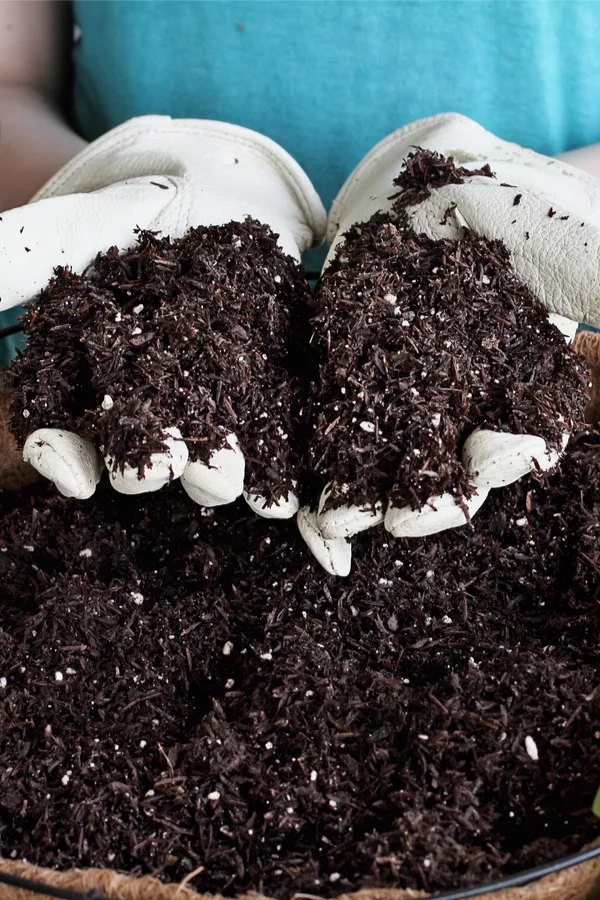When you plant your own hanging baskets, you can easily add unique and amazing beauty to your porch, patio and outdoor landscape – and save hundreds of dollars in the process!
One of our favorite ways to add big color and interest all over the farm is with homemade hanging baskets. They are great for brightening up decks, patios and sitting areas, not to mention beautifying pergolas, pavilions and all kinds of outdoor structures.
But can they ever be incredibly expensive to purchase! Depending on the size of the basket, hanging baskets can range anywhere from twenty to thirty dollars – all the way up to a hundred dollars or more.
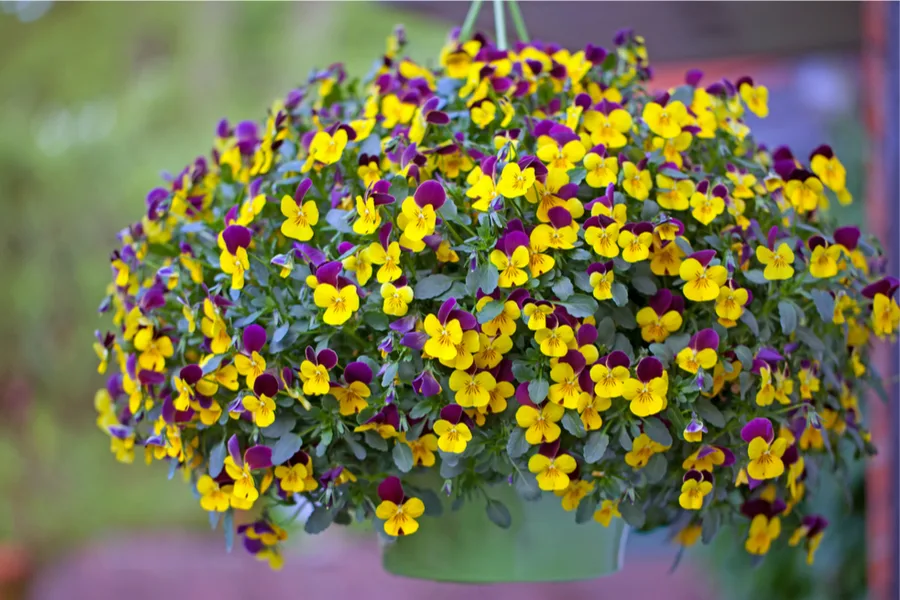
But perhaps just as frustrating, many store-bought baskets outgrow their containers and soil by mid-summer. Not only can it be quite disheartening, it can make the whole process even more expensive if you have to replace them.
The Issue With Store Bought Hanging Baskets
Most store-bought containers and baskets have been growing for months indoors by the time you purchase them in early spring.
Greenhouses and growers do this to have big beautiful flowers to showcase big blooms and attract customers. The only problem is that in most cases, the basket’s roots are often already running out of space. Unfortunately, that means your basket is already on borrowed time.
The good news is you don’t have to have “hanging basket” frustration any more. By planting your own baskets in the spring and following a few simple but key tips, you can create gorgeous planters that overflow with color – and last the entire season as well.
With that in mind, here is a look at how to easily plant your own hanging baskets with big success this year!
How To Plant Your Own Hanging Baskets – The Simple Secrets To Success
Start With Bigger Baskets
One thing we’ve learned over the years is that the size of the basket makes a huge difference when it comes to long-term success. Although smaller baskets can be less-expensive, they simply don’t allow enough growing space for plants. Especially if you want them to last all season long!
It is a simple fact, the more soil that can be used, the more your plants will thrive. In smaller baskets, by mid-summer, there is little room left for roots to expand. As a result, plants become become root-bound.
Once a plant is root bound, it is nearly impossible to give it lasting water or nutrients. As you water, it flows directly through and out the bottom. And the fertilizer you might be using? It does the exact same thing.
Without replanting a root bound basket, the foliage will become weak and brittle, and the blooms will all but disappear. And in the end, you are left with a plant that is anything but appeasing to the eye.
What Size Basket Is Best – How To Plant Your Own Hanging Baskets
Any basket less than 14 inches in diameter simply won’t work for the long term. 10 and 12 inch pots look great when first planted, but they quickly outgrow their container.
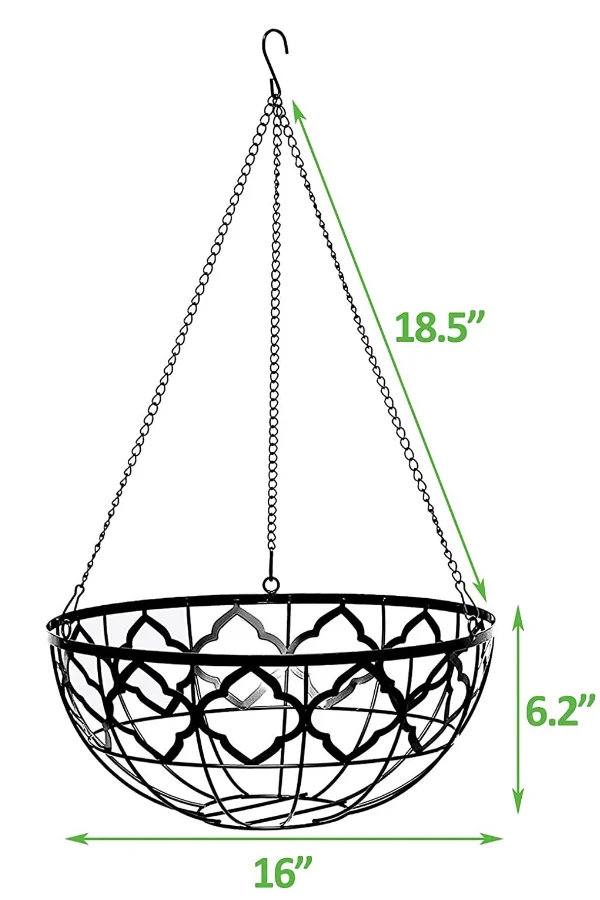
14 inch baskets work well, but our personal favorites are the 16 inch metal wire baskets. At 16″inches in diameter, they allow plenty of room for growth. Even better, at that size, they are still not overly heavy to lift and hang.
No matter what, the real key to success is to keep with baskets that are 14 inches or bigger. It allows plants to have enough room to grow for an entire season without issue. Product Links : 14 inch wire baskets – 16 inch wire baskets
Plastic Baskets vs. Wire Baskets – How To Plant Your Own Hanging Baskets
As for plastic containers vs. wire baskets, we are much bigger fans of the wire versions. And not just for looks.
Plastic containers actually create a couple of issues for plants. For one, the covering of plastic around the entire root ball holds in heat. And in the middle of summer, excessive heat can spell trouble for plants. In addition, the full, non-porous covering makes it harder for oxygen to reach roots.
Wire baskets that use a fibrous coco coir liner or an all-natural weave liner allow air to easily enter. They also help excess water drain away much quicker than plastic containers do. Best of all, natural liners are usually fairly inexpensive and easy to replace year after year.
Listen In To Our Podcast On Hanging Basket Care Below For Even More Basket Care Info!
Wire baskets will cost a bit more up-front, but on the upside they can last for years. Plastic baskets on the other hand rarely make it more than a single season. In fact, sometimes they don’t even make it through the first season!
Selecting The Best Soil For Hanging Baskets – How To Plant Your Own Hanging Baskets
Once you have your basket in hand and ready to go, the next step is to fill it with great soil. If there is one thing not to skimp on, it is your potting soil mix.
Whether you make your own, or purchase ready made potting soil, look for a lightweight mix that is rich, loose and nutrient filled. Remember, container plants are stuck the entire year with the soil they are planted in, so it is important to start them off with good, rich soil.
Although there are a slew of high-quality potting mixes available, we make our own with a simple combination of topsoil, compost, perlite, worm castings and coffee grounds. See : The Perfect Homemade Potting Soil Recipe
Not only does it save big on the budget, it allows us to create a lightweight, super-charged potting soil that teems with nutrients. If you do purchase your own, don’t be afraid to add a cup or so of additional worm castings to the soil in each basket. Worm castings are amazing at helping to power annuals!
Selecting The Best Plants – How To Plant Your Own Hanging Baskets
When it comes to what plants work best in hanging baskets, the key to success starts with selecting varieties that produce heavy bloom sets without too much foliage. After all, flowers win out over greenery every time when it comes to the “WOW” factor!
Calibrachoa (Million Bells), Wave petunias, begonias, impatiens, lantana and verbena are all excellent annuals for planting and growing in hanging baskets. All have incredible flower sets, and all, if properly cared for, can last an entire growing season in full bloom.
But don’t think you just have to select the standards. You can also think outside of the box for great homemade baskets too. We love planting some of our homemade hanging baskets using ornamental peppers.
Their thick, dark foliage is a wonderful contrast to the hundreds of colorful pepper “blooms” that cover the plant. Ornamental peppers also are extremely drought and heat tolerant, making them great for handling the hot summer sun.
Chili-chili and Sangria ornamental peppers are two of our favorites for planting in baskets. Both have pepper blooms that cover the plant in gorgeous color!
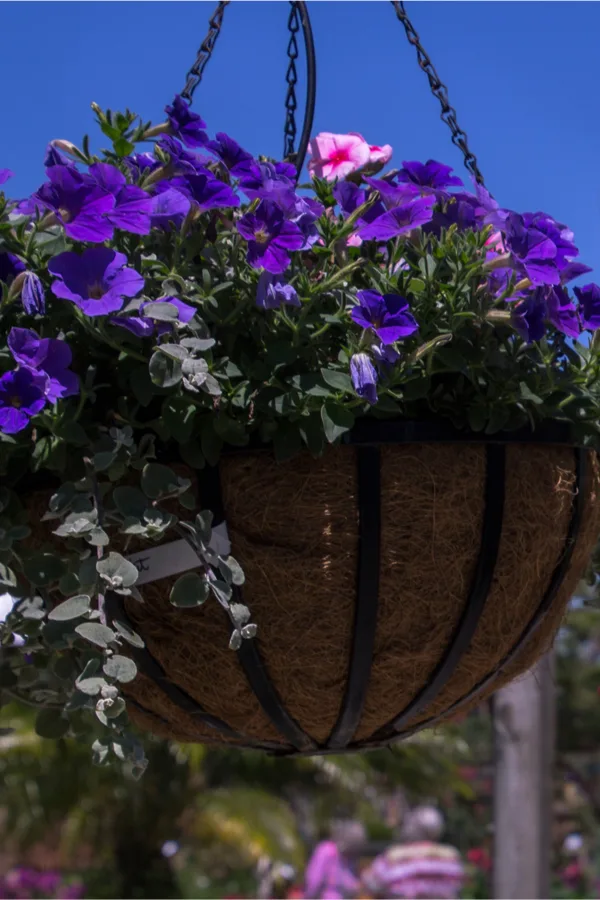
How Many Plants To Plant – How To Plant Your Own Hanging Baskets
Equally as important to what you choose to grow is how many plants you plant in each basket. There always seems to be the temptation to overfill or over-plant hanging baskets and containers. Unfortunately, it quickly leads to problems for your baskets.
The issue of over-planting is certainly understandable. After all, we want the flowers to fill the space and look incredible from the very first day.
But the issue with over-planting is that it allows no room for future growth. As plants begin to expand, they quickly become overcrowded. They compete for the same moisture and nutrients – and with little space, there is little of both to go around.
The key to success is planting for the long haul. For our 16″ baskets, we use 7 annual plants. We evenly space 5 around the edges, and then place two in the middle. For 14″ baskets, we use 5 to 6, spacing in much the same way.
It may seem a little bare for the first few weeks, but they have room to expand. Planting this way ensures your plants can make it through an entire growing season in bloom.
Fertilizing For Success – How To Plant Your Own Hanging Baskets
Even with great soil from the start, hanging baskets will need additional nutrients to keep blooming all season long. Unfortunately, without additional help, they will fail early.
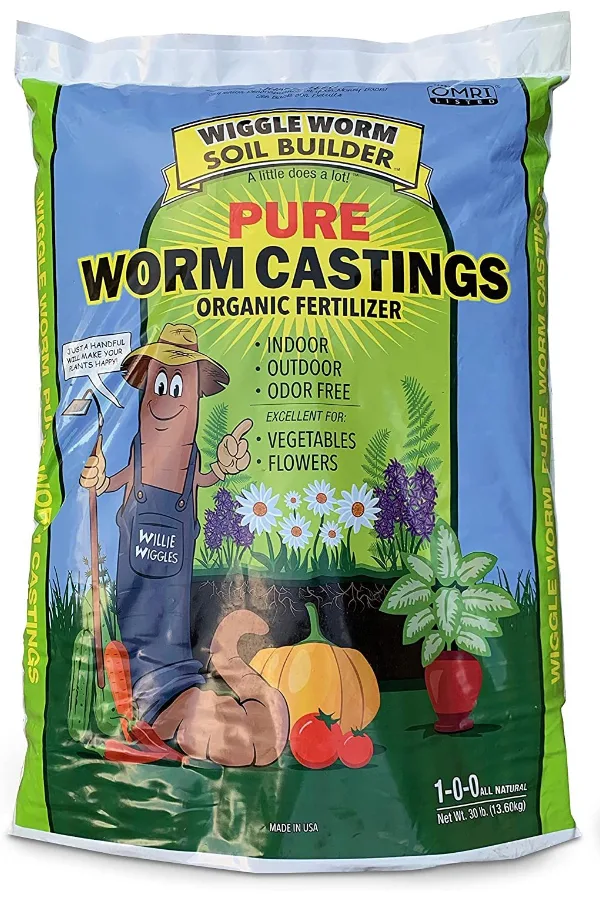
The key to success in fertilizing hanging baskets is to use a slow and steady approach. It is important to fertilize in small regular doses. This helps to keep plants strong, without allowing them to get too big, too fast.
We use a two-prong approach for fertilizing our baskets. For starters, once a month, we use about a cup of worm castings on the surface of each basket. This acts as a slow-release fertilizer. Every time we water, the nutrients from the castings leach to the roots in the soil below.
In addition to the castings on top of the plants, we also fertilize our baskets every two weeks with a light liquid fertilizer. You can use compost tea, worm casting tea, or even a good liquid all-purpose fertilizer for this feeding.
Feed Lightly!
The key is to keep the feeding light. When using compost or worm casting tea, the energy is already tamed down perfectly for hanging baskets. For a commercial liquid fertilizer, you can often use them at 1/4 to 1/2 strength for the same effect.
By supplying a lower dose every two weeks, your plants get fed just enough to keep them strong and flowering, but no so much they overgrow. This feeding schedule also happens to work wonders on container plants too! See: How To Make Homemade Compost Tea
The Importance of Regular Watering – How To Plant Your Own Hanging Baskets
Last but not least, how and when you water is just as vital to a plants short and long-term success as the soil, plants and fertilizing schedule you use.
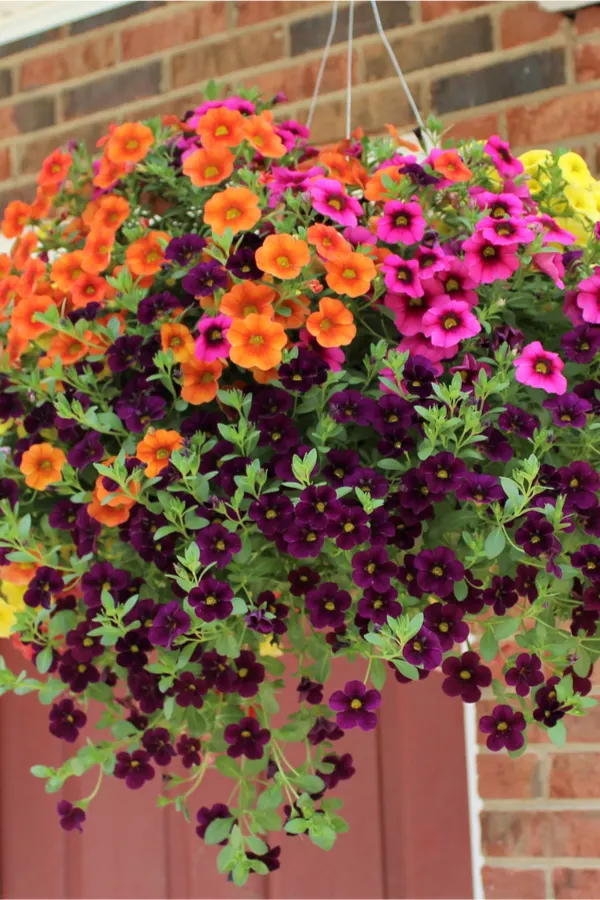
It is important to realize that hanging plants dry out much faster than those in beds. Being suspended in the air, there is nothing to help insulate their moisture. Because of this, most hanging baskets need water on a daily basis. In fact some may even require morning and evening waterings.
The best time to water hanging baskets is in the early morning. It gives plants the moisture needed to make it through the heat of the day. The next best time is the early evening.
Mid day waterings unfortunately can cause issues for the plants. For starters, the sun hitting the water droplets can burn the foliage and blooms. If you do have to water mid-day, water at the base of plants and avoiding hitting the foliage as much as possible.
Here’s to planting your own hanging baskets this year, and to amazing flowering success. Happy Gardening! Jim and Mary.
Jim and Mary Competti have been writing gardening, DIY and recipe articles and books for over 15 years from their 46 acre Ohio farm. The two are frequent speakers on all things gardening and love to travel in their spare time.
As always, feel free to email us at thefarm@owgarden.com with comments, questions, or to simply say hello! You can sign up for our free email list in the subscribe now box in the middle of this article. Follow us on Facebook here : OWG Facebook. This article may contain affiliate links.


